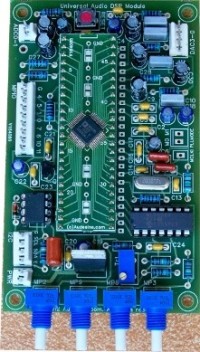A Universal Through-Hole Audio DSP Board Based on the ADAU1701 [130232-I]

It seems that to get your feet wet in the ocean of DSP you seem to need lots of SMD soldering skills and also a lot of math. Well, not any more. Here is a Universal Audio DSP board for the DIYer. Based on the Analog Devices ADAU1701, this board has only through-hole components (except for the ADAU1701 itself)!
It seems that to get your feet wet in the ocean of DSP you seem to need lots of SMD soldering skills and also a lot of math. Well, not any more. Here is a Universal Audio DSP board for the DIYer. Based on the Analog Devices ADAU1701, this board has only through-hole components (except for the ADAU1701 itself)! It features stereo audio input and 4 DAC outputs, 4 pots that feed into aux ADC inputs buffered by a rail-to-rail quad op amp, and 8 additional general-purpose digital I/O (GPIO) pins. An I2C EEPROM plugs into a 8DIP socket. If you want to get adventurous, the PLL_MODE and MCLKI pins of the DSP chip are also brought out for maximum flexibility but you can simply ignore them to begin with. The board accepts two widths of 48-pin DIP socket - a standard 0.6 inch as well as the 0.7-inch Schmartboard (R) so you can plug in the ADAU1701 after soldering it to either type of adapter. Programming the EEPROM requires no special hardware or software - there are several simple schematics available on the web using which you can build an RS232-based programmer in minutes for under $5. The board also brings out the I2C programming pins for convenient programming. I chose this particular DSP chip for an important reason. It, and the associated (free!) development environment SigmaStudio, are targeted at those who want an easy migration path from analog designs. SigmaStudio requires no programming - just drag and drop prebuilt blocks such as "State Variable Filter" and there - you have a circuit in minutes which can either be implemented as a DSP platform or simulated using this board and then implemented as an analog platform! So there you have it - an easy-to-assemble DSP board, featuring analog and digital I/O, easily programmable with no special hardware, in an environment that allows you to go for a finished product that is DSP-based or analog. All with no math!
The schematic is based on the standard self-boot schematic in the ADAU1701 datasheet, with additions as illustrated in the attached Supplement.
Update 17/12/2013: video!
Update 29/01/2015
We received a contribution from Christian Weidner who converted our programmer software into a stand-alone Sigma Studio HEX file converter tool. Source code and executable are available below. He also suggests to use the CH341 USB interface for fast programming. You can find it on eBay.



Discussion (6 comments)